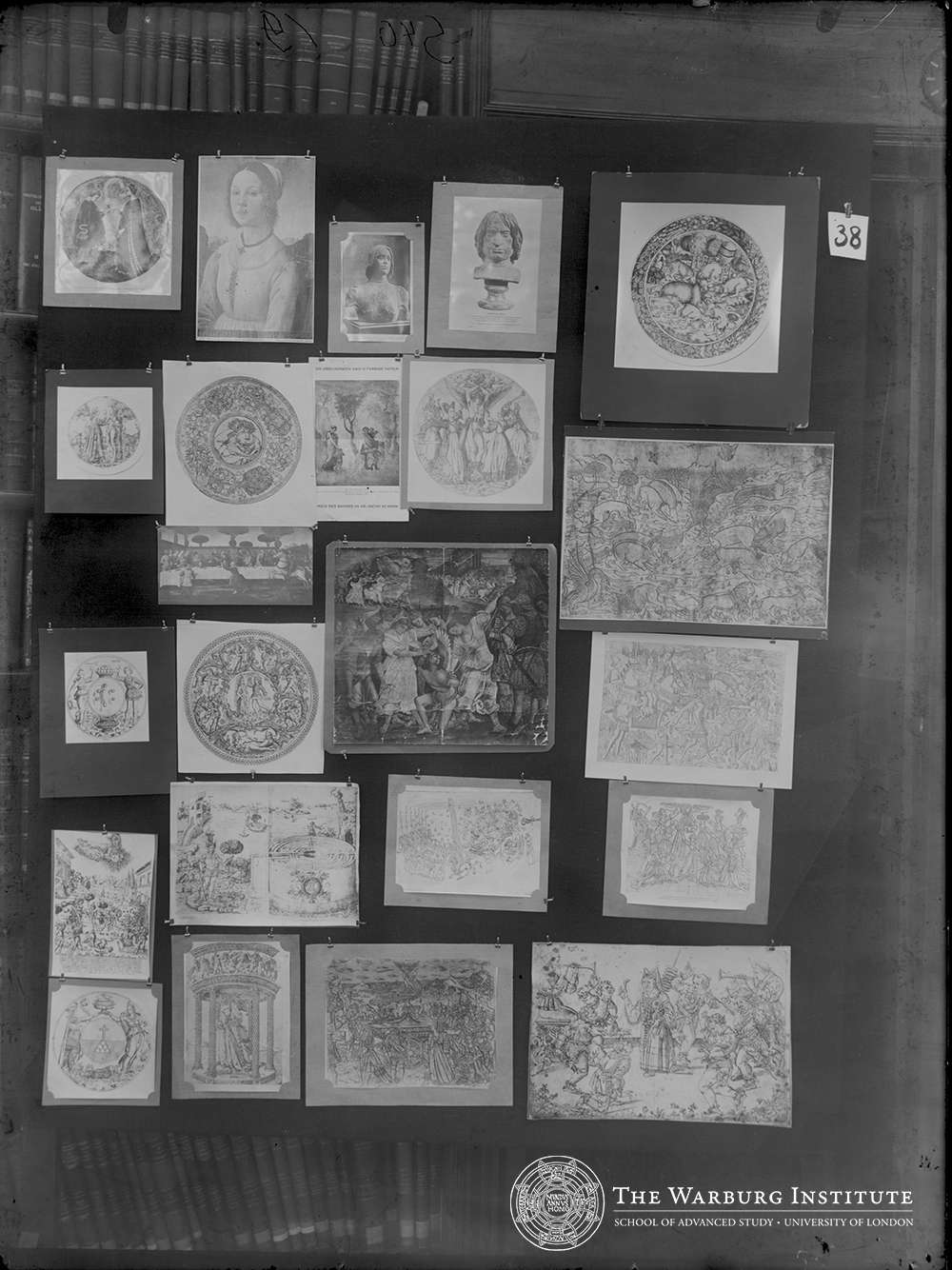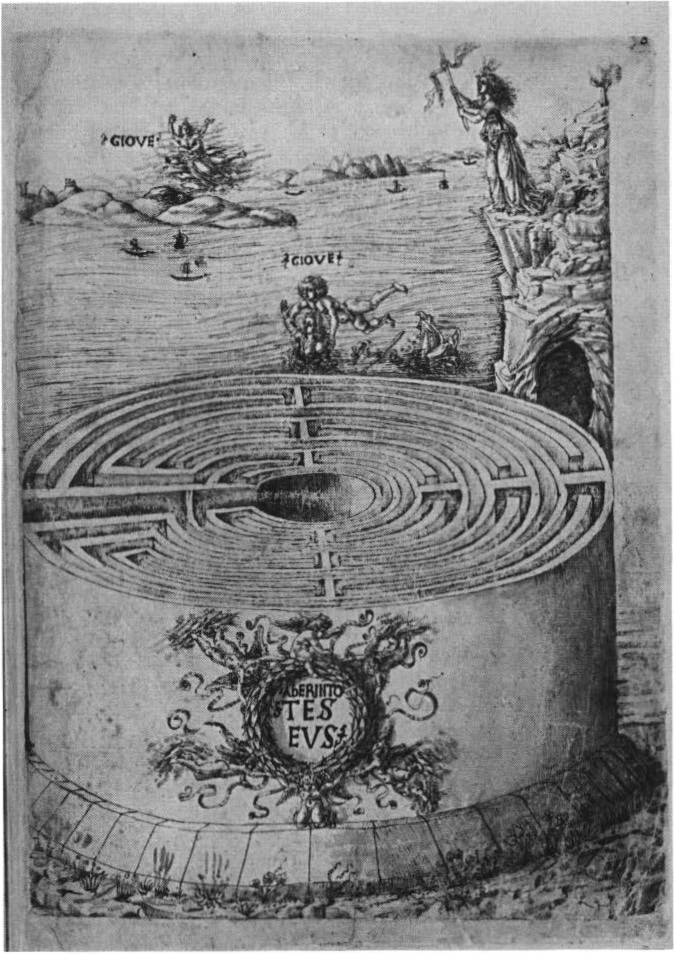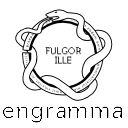Mnemosyne Atlas 38
Paride e Elena in stile composito
Preliminari e rituali amorosi: corteggiamento e simbolismo erotico tra arte cortese e Botticelli . I rituali cortesi del corteggiamento (tema del trionfo d’amore, capselle nuziali) – o la loro negazione orgiastica e festiva (tema della 'punizione d’amore', 'lotta per i pantaloni') – nei veicoli dell’arazzo e dell’incisione: lo stile ibrido delle raffigurazioni, preliminare all’arte di Botticelli, interseca temi, posture e dettagli stilistici antichi con il realismo 'alla franzese'.
Paris and Helen in composite style
The rituals of courtship and love: the erotic symbolism of love and courtship in courtly art and Botticelli. Chivalrous rituals of courtship (theme of the triumph of love, nuptial chests) or their orgiastic and festive opposite (the theme of the 'punishment of love', ‘fight for the trousers’) in tapestries and engravings: hybrid style depictions, forerunners of Botticelli’s style, intertwine ancient themes, postures and stylistic details with 'alla franzese' realism.

Appunti di Aby Warburg (1929)
Kpfst. Baldini. Festw.
Incisione Baldini, cultura della festa.
Appunti di Aby Warburg e collaboratori (1929)
Mischstil in Bezug auf Antike. Höfisches Leben. Liebessymbolik. Vorstufe zu Botticelli in der Auseinandersetzung m.d. Antike. Teppich ersetzt durch Stiche (Jagd). Minnekästchen. Distanz in der Werbung: Bestrafung Amors. Noli me tangere. Bestrafte Kälte (Nostagio) und Herzessen. Triumph Amors. Hosenkampf u. Quaresima italienisch. Paris u. Helena im Mischstil. Baldini 1. Fassung Sol.
Stile misto in rapporto con l'antico. Vita di corte. Simbolismo d’Amore. Fase del confronto con l'antico che precede Botticelli. Arazzo sostituito da incisioni (caccia). Cofanetti d’amor cortese. Presa di distanza nel corteggiamento: punizione di Amor. Noli me tangere. Freddezza punita (Nastagio) e mangiare il cuore. Trionfo di Amor. Lotta per i pantaloni e quaresima italiana. Paride ed Elena in stile misto. Baldini 1. Versione Sol.
Appunti di Gertrud Bing (1940 ca)
Der Bilder kreis und die Stilstufe der Otto–prints und des frühen Florent. Kupferstichs, “Die Freigelassen des Temperaments und ihre Bändigung”. A) Die sittsame Liebe 1) Höfisch + emblematisch verhüllt im Medici-kreis. Die Protagonisten + 4 Tondi. (Nicht “Spero”) 2) Der bestrafte Amor: Antike (gehört nach vorne), Stich, Signorelli. Dazu aber ergänzend: Nastagio degli Innocenti, Strafe für hartherzig Verschmähung. (Herz-Essen spielt hierein). 3) Triumphmotiv. Stich=Amor. Botticelli was? Gehört Paris hierher als “berühmtes Liebespaar”? Unten Sittsam, oben Ausgelassenheit als Fries. Venus stich – Rechtfertigung durch d. Abhängigkeit von den Sternen. Begehrlichkeit rund um ein Objekt. Hosen Kampf + Quaresima stehen auch für Italien. Abhängigkeit von nordischen Vorbildern. B) Jagd + Vergnügen im Freien. Hundegruppe v. supra. Der Typus des Wilden Mannes als Produkt a contrario der höf. Gesellschaft. Dazu gehört wohl auch der Bacchus was bedeutet. Theseus + das Labyrinth (außer daß das Flor. Picture Chronicle stilistisch hierhergehört).
Il contesto pittorico e lo stile delle “stampe Otto” e delle prime incisioni su rame fiorentine, “La liberazione del temperamento e il suo addomesticamento”. A) L’amore pudico 1) Cortese + emblematicamente velato nella cerchia medicea. I protagonisti + 4 tondi (non “Spero”) 2) Il Cupido punito: l’Antico (va collocato prima), l’incisione, Signorelli. Ma anche Nastagio degli Innocenti, punizione per il rifiuto spietato (mangiare il cuore si inserisce in questo contesto). 3) Motivo del trionfo. Incisione= Amor. Botticelli in che senso? Paride è inserito qui come “coppia di amanti famosi”? Sotto il pudore, sopra l’esuberanza come fregio. Incisione di Venere – giustificazione della dipendenza dagli astri. Desiderio per un oggetto. Lotta per i pantaloni + Quaresima sono validi anche in Italia. Dipendenza dai modelli nordici. B) Caccia + attività all’aperto. Gruppo di cani, vedi sopra. La tipologia dell’uomo selvatico come esito a contrario della società cortese. Potrebbe essere pertinente anche Bacco, il che significa Teseo + il labirinto. (Oltre al fatto che la Cronaca fiorentina figurata stilisticamente è pertinente a questa Tavola).
Appunti di Aby Warburg (1929)
Kpfst. Baldini. Festw.
Baldini engraving, festive culture.
Notes by Aby Warburg and coll. (1929)
Mischstil in Bezug auf Antike. Höfisches Leben. Liebessymbolik. Vorstufe zu Botticelli in der Auseinandersetzung m.d. Antike. Teppich ersetzt durch Stiche (Jagd). Minnekästchen. Distanz in der Werbung: Bestrafung Amors. Noli me tangere. Bestrafte Kälte (Nostagio) und Herzessen. Triumph Amors. Hosenkampf u. Quaresima italienisch. Paris u. Helena im Mischstil. Baldini 1. Fassung Sol.
Mixed style in relation to antiquity. Courtly life. Love symbolism. Precursors to Botticelli in engagement with Antiquity. The tapestry replaced by the print (hunt). Courtly love caskets. Distance in courtship: Amor’s punishment. Noli me tangere. Coldness punished (Nastagio degli Onesti). The triumph of Amor. The Fight for the Trousers and Quaresima/Lent, Italian. Paris and Helen in mixed style. Baldini, first version, Sol.
Notes by Gertrud Bing (ca. 1940)
Der Bilder kreis und die Stilstufe der Otto–prints und des frühen Florent. Kupferstichs, “Die Freigelassen des Temperaments und ihre Bändigung”. A) Die sittsame Liebe 1) Höfisch + emblematisch verhüllt im Medici-kreis. Die Protagonisten + 4 Tondi. (Nicht “Spero”) 2) Der bestrafte Amor: Antike (gehört nach vorne), Stich, Signorelli. Dazu aber ergänzend: Nastagio degli Innocenti, Strafe für hartherzig Verschmähung. (Herz-Essen spielt hierein). 3) Triumphmotiv. Stich=Amor. Botticelli was? Gehört Paris hierher als “berühmtes Liebespaar”? Unten Sittsam, oben Ausgelassenheit als Fries. Venus stich – Rechtfertigung durch d. Abhängigkeit von den Sternen. Begehrlichkeit rund um ein Objekt. Hosen Kampf + Quaresima stehen auch für Italien. Abhängigkeit von nordischen Vorbildern. B) Jagd + Vergnügen im Freien. Hundegruppe v. supra. Der Typus des Wilden Mannes als Produkt a contrario der höf. Gesellschaft. Dazu gehört wohl auch der Bacchus was bedeutet. Theseus + das Labyrinth (außer daß das Flor. Picture Chronicle stilistisch hierhergehört).
The pictorial context and style of the “Otto prints” and early Florentine copper engravings, “The liberation of temperament and its taming”. A) Modest love
1) Courtly + emblematically veiled in the Medici circle. The protagonists + 4 rounds (not “Spero”) 2) The punished Cupid: the Antique (must be placed first), the engraving, Signorelli. But also Nastagio degli Innocenti, punishment for merciless rejection (eating the heart fits into this context). 3) Reason for triumph. Engraving= Amor. Botticelli in what sense? Is Paris inserted here as a “famous pair of lovers”? Below modesty, above exuberance as frieze. Engraving of Venus – justification of dependence on the stars. Desire for an object. Fight over the trousers + Quaresima are also valid in Italy. Dependence on Nordic models. B) Hunting + outdoor activities. Group of dogs, vedi supra. The type of the Wild Man as outcome a contrario of courtly society. Bacchus could also be relevant, meaning Theseus + the labyrinth. (In addition to the fact that the figured Florentine Chronicle stylistically belongs here).

1. Cerchia di Giovanni di Paolo, Un giovane porge a una donna il suo cuore ardente, sulla sua veste l'impresa di un albero verdeggiante, particolare della decorazione di una cassetta di fidanzamento (capsella), Firenze, sec. XV (già Wien, A. Figdor Sammlung).
2. Lorenzo di Credi (attribuzione), Noli me tangere (didascalia nell'immagine), ritratto di donna, dipinto 1485-90, Berlin, Staatliche Museen, Gemäldegalerie.
3. Cerchia del Verrocchio, Busto in argilla di Lorenzo de' Medici, 1466 ca., Boston, Museum of Fine Arts.
4. Stefano Ricci (da Antonio Pollaiolo?), Busto di Lorenzo de' Medici, presumibilmente tratto dalla sua maschera mortuaria nel 1492, terracotta, 1825, Oxford, Ashmolean Museum, Fortnum Collection.
5. Cacciatore di orsi, acquaforte fiorentina su rame, 1465-1480, London, Rothschild Collection.
6. Donna che ruba il cuore di un uomo legato a un albero, acquaforte fiorentina su rame, 1465-1480, London, The British Museum.
7. Busto grottesco di un suonatore di liuto, acquaforte fiorentina su rame, 1465-1480, London, The British Museum.
8. Punizione di Eros, pittura parietale dalla Casa dell'Amore punito a Pompei, 14-37 d.C., Napoli, Museo Archeologico Nazionale.
9. Punizione di Amore, acquaforte fiorentina su rame, 1465-1480 ca.
10. Scene venatorie, acquaforte fiorentina su rame, 1460 ca., London, The British Museum.
11. Bertoldo di Giovanni, Banchetto di Nastagio nella pineta, raffigurazione da Boccaccio, Decamerone, V nov. 8, cassone (per le nozze Pucci-Bini?), 1483 ca. Philadelphia, John Johnson Collection.
12. Luca Signorelli, Trionfo della castità, Amore disarmato e legato, affresco intelato da Palazzo Petruccini a Siena, 1509 ca., London, National Gallery.
13. Una spedizione di caccia s'imbatte in un gruppo di selvaggi, acquaforte fiorentina su rame, 1465-80 ca., London, The British Museum.
14. Gioco con lo stemma dei Medici (giovane coppia), acquaforte fiorentina su rame, seconda metà del sec. XV, Harvard (Mass.), Fogg Art Museum.
15. Coppia che danza alla musica del cembalo, acquaforte fiorentina su rame, 1465-1480, London, The British Museum.
16. Il sole come uno dei sette pianeti e i suoi figli, acquaforte fiorentina su rame dal cosiddetto Calendario Baldini, 1460 ca., London, The British Museum.
17. Baccio Baldini (attribuito), Giasone e Medea, acquaforte su rame, 1465-1480 ca., London, The British Museum.
18. Maso Finiguerra (attribuito), Teseo e Arianna a Creta, acquaforte fiorentina su rame dalla cosiddetta Cronaca fiorentina figurata, 1475 ca., London, The British Museum, Department of Prints and Drawings.
19. Maso Finiguerra (attribuito), Labirinto di Dedalo, acquaforte fiorentina su rame dalla cosiddetta Cronaca fiorentina figurata, 1475 ca., London, The British Museum, Department of Prints and Drawings.
20. Maso Finiguerra (attribuito), Ratto di Elena, acquaforte fiorentina su rame dalla cosiddetta Cronaca fiorentina figurata, 1475 ca., London, The British Museum, Department of Prints and Drawings.
21. Sandro Botticelli, illustrazione per la Divina Commedia di Dante, Purgatorio, canto XXX, disegno a penna su pergamena, 1482 ca., Berlin, Staatliche Museen, Kupferstichkabinett.
22. Baccio Baldini (attribuito), Trionfo d'Amore, dal testo di Petrarca, acquaforte fiorentina su rame, 1460-1470.
23. Baccio Baldini (attribuito), Lotta e danza dei pantaloni, acquaforte fiorentina su rame, 1465 ca., München, Graphische Sammlung.
24. Monogrammista S.E., Derisione della Quaresima, danza moresca, acquaforte fiorentina su rame, 1475-1490.
1. Circle of Giovanni di Paolo, A young man holds out his burning heart to a woman, detail of decoration of an engagement case (capsella), c. XV. From M.J. Friedländer, O. von Falke, P. Cassirer, Die Sammlung Dr. Albert Figdor , Berlino 1930, vol. 1, 5, p. CXL.
2. Lorenzo di Credi (attributed), Woman portrait, (Noli me tangere), oil on panel, painting 1485-90. Berlin, Staatliche Museen, Gemäldegalerie.
3. Circle of Verrocchio, Bust of Lorenzo de’ Medici, clay, 1466 ca. Boston, Museum of Fine Arts.
4. Stefano Ricci (from Antonio Pollaiolo?), Bust of Lorenzo de’ Medici, clay, 1825. Oxford, Ashmolean Museum.
5. Baccio Baldini (attributed), A bear attacked by dogs in a rocky landscape, etching on copper, 1465-1480. London, British Museum.
6. Baccio Baldini (attributed), The Cruelty of Love, etching on copper, 1465-1480. London, The British Museum.
7. Baccio Baldini (attributed), Grotesque lute-player playing his instrument, etching on copper, 1465-1480. London, The British Museum.
8. Eros punishment, fresco from the House of Punished Love in Pompeii, 14-37 A.D. Naples, National Archaeological Museum.
9. Baccio Baldini (attributed), The Chastisement of Cupid, etching on copper, 1465-1480 ca. London, British Museum.
10. Hunting scenes, etching on copper, 1460 ca. London, The British Museum.
11. David Ghirlandaio, Banquet of Nastagio in the pine forest, temple on panel, final del c. XV. Philadelphia, John Johnson Collection.
12. Luca Signorelli, Triumph of chastity, fresco on canvas from Palazzo Petruccini in Siena, 1509 ca. London, National Gallery.
15. Baccio Baldini (attributed), A pair of dancers, etching on copper, 1465-1480. London, The British Museum.
16. Baccio Baldini (attributed), The sun as one of the seven planets and its children, etching on copper from the so-called Baldini’s calendar, 1460 ca. London, The British Museum.
17. Baccio Baldini (attributed), Jason and Medea, etching on copper, 465-1480 ca. London, The British Museum..
18. The Cretan labyrinth with the story of Theseus and Ariadne, etching on copper from the so-called figured florentine Chronicle, 1475 ca. London, The British Museum.
19. The Cretan labyrinth with the story of Theseus and Ariadne, etching on copper from the so-called figured florentine Chronicle, 1475 ca. London, The British Museum.
20. Rape of Elena, etching on copper from the so-called figured florentine Chronicle, 1475 ca. London, The British Museum.
21. Jacopo Bellini (o Pisanello), Deianira’s rape, painting, 1460 ca., London, Agnew Collection.
21. Sandro Botticelli, Purgatory XXX, pen drawing on parchment, 1482 ca. Berlin, Staatliche Museen, Kupferstichkabinett, Ms. Hamilton 201.
22. Baccio Baldini (attributed), Fight and dance of the pants, etching on copper, 1465 ca. München, Graphische Sammlung.
23. Baccio Baldini (attributed), Triumph of Love, etching on copper, 1460-1470.
24. Monogramist S.E., Lent Mockery (moorish dance), etching on copper, 1475-1490.


38_1 | Cerchia di Giovanni di Paolo, Un giovane porge a una donna il suo cuore ardente, sulla sua veste l'impresa di un albero verdeggiante , particolare della decorazione di uno scrigno di fidanzamento (capsella), sec. XV. In M.J. Friedländer, O. von Falke, P. Cassirer, Die Sammlung Dr. Albert Figdor , Berlino 1930, vol. 1, 5, p. CXL.
38_1 | Circle of Giovanni di Paolo, A young man holds out his burning heart to a woman, detail of decoration of an engagement case (capsella), c. XV. From M.J. Friedländer, O. von Falke, P. Cassirer, Die Sammlung Dr. Albert Figdor , Berlino 1930, vol. 1, 5, p. CXL.

38_2 | Lorenzo di Credi (attribuzione), Ritratto di ragazza con corallo (Noli me tangere), olio su tavola, 1485-90. Berlin, Staatliche Museen, Gemäldegalerie.
38_2 | Lorenzo di Credi (attributed), Woman portrait, (Noli me tangere), oil on panel, painting 1485-90. Berlin, Staatliche Museen, Gemäldegalerie.

38_3 | Cerchia del Verrocchio, Busto in di Lorenzo de’ Medici, terracotta, 1466 ca. Boston, Museum of Fine Arts.
38_3 | Circle of Verrocchio, Bust of Lorenzo de’ Medici, clay, 1466 ca. Boston, Museum of Fine Arts.

38_4 | Stefano Ricci (da Antonio Pollaiolo?), Busto di Lorenzo de' Medici, terracotta, 1825. Oxford, Ashmolean Museum.
38_4 | Stefano Ricci (from Antonio Pollaiolo?), Bust of Lorenzo de’ Medici, clay, 1825. Oxford, Ashmolean Museum.

38_5 | Baccio Baldini (attribuito), Un orso attaccato dai cani in un paesaggio roccioso, acquaforte su rame, 1465-1480, Londra, The British Museum.
38_5 | Baccio Baldini (attributed), A bear attacked by dogs in a rocky landscape, etching on copper, 1465-1480. London, British Museum.
In the Panel: Photo print.

38_6 | Baccio Baldini (attribuito), Crudeltà di amore, acquaforte fiorentina su rame, 1465-1480. Londra, The British Museum.
38_6 | Baccio Baldini (attributed), The Cruelty of Love, etching on copper, 1465-1480. London, The British Museum.

38_7 | Baccio Baldini (attribuito), Busto grottesco di un suonatore di liuto, acquaforte su rame, 1465-1480. Londra, The British Museum.
38_7 | Baccio Baldini (attributed), Grotesque lute-player playing his instrument, etching on copper, 1465-1480. London, The British Museum.

38_8 | Punizione di Eros, affresco staccato dalla Casa dell'Amore punito a Pompei, 14-37 d.C. Napoli, Museo Archeologico Nazionale.
38_8 | Eros punishment, fresco from the House of Punished Love in Pompeii, 14-37 A.D. Naples, National Archaeological Museum.

38_9 | Baccio Baldini (attribuito), Punizione di Amore, acquaforte su rame, 1465-1480 ca. Londra, The British Museum.
38_9 | Baccio Baldini (attributed), The Chastisement of Cupid, etching on copper, 1465-1480 ca. London, British Museum.

38_10 | Incisore fiorentino, Scena venatoria, acquaforte su rame, 1460 ca. Londra, The British Museum.
38_10 | Hunting scenes, etching on copper, 1460 ca. London, The British Museum.

38_11 | David Ghirlandaio, Banchetto di Nastagio nella pineta, tempera su tavola (70.2 × 135.9 cm), fine del XV sec. Filadelfia, John Johnson Collection.
38 _11 | David Ghirlandaio, Banquet of Nastagio in the pine forest, temple on panel, final del c. XV. Philadelphia, John Johnson Collection.

38 _12 | Luca Signorelli, Trionfo della castità, affresco staccato da Palazzo Petruccini a Siena, 1509 ca. Londra, National Gallery.
38_12 | Luca Signorelli, Triumph of chastity, fresco on canvas from Palazzo Petruccini in Siena, 1509 ca. London, National Gallery.


38_15 | Baccio Baldini (attribuito), Coppia che danza, acquaforte su rame, 1465-1480. Londra, The British Museum.
38_15 | Baccio Baldini (attributed), A pair of dancers, etching on copper, 1465-1480. London, The British Museum.

38_16 | Baccio Baldini (attribuito), Il sole come uno dei sette pianeti e i suoi figli, acquaforte su rame dal cosiddetto Calendario Baldini, 1460 ca. Londra, The British Museum.
38_16 | Baccio Baldini (attributed), The sun as one of the seven planets and its children, etching on copper from the so-called Baldini’s calendar, 1460 ca. London, The British Museum.

38_17 | Baccio Baldini (attribuito), Giasone e Medea, acquaforte su rame, 1465-1480 ca. Londra, The British Museum.
38_17 | Baccio Baldini (attributed), Jason and Medea, etching on copper, 465-1480 ca. London, The British Museum.

38_18 | Incisore fiorentino, Teseo e Arianna a Creta, acquaforte su rame dalla cosiddetta Cronaca fiorentina figurata di Maso Finiguerra, 1475 ca. Londra, The British Museum.
38_18 | The Cretan labyrinth with the story of Theseus and Ariadne, etching on copper from the so-called figured florentine Chronicle, 1475 ca. London, The British Museum.

38_19 | Incisore fiorentino, Labirinto di Dedalo, acquaforte su rame dalla cosiddetta Cronaca fiorentina figurata di Maso Finiguerra, 1475 ca. Londra, The British Museum.
38_19 | The Cretan labyrinth with the story of Theseus and Ariadne, etching on copper from the so-called figured florentine Chronicle, 1475 ca. London, The British Museum.

38_20 | Incisore fiorentino, Ratto di Elena, acquaforte su rame dalla cosiddetta Cronaca fiorentina figurata di Maso Finiguerra, 1475 ca. Londra, The British Museum.
38 _20 | Rape of Elena, etching on copper from the so-called figured florentine Chronicle, 1475 ca. London, The British Museum.

38_21 | Sandro Botticelli, Purgatorio XXX, disegno a penna su pergamena, 1482 ca. Berlino, Staatliche Museen, Kupferstichkabinett, Ms. Hamilton 201.
38_21 | Sandro Botticelli, Purgatory XXX, pen drawing on parchment, 1482 ca. Berlin, Staatliche Museen, Kupferstichkabinett, Ms. Hamilton 201.

38_22 | Baccio Baldini (attribuito), Lotta e danza dei pantaloni, acquaforte su rame, 1465 ca. München, Graphische Sammlung.
38_22 | Baccio Baldini (attributed), Fight and dance of the pants, etching on copper, 1465 ca. München, Graphische Sammlung.

38_23 | Baccio Baldini (attribuito), Trionfo d'Amore, acquaforte su rame, 1460-1470.
38_23 | Baccio Baldini (attributed), Triumph of Love, etching on copper, 1460-1470.

38_24 | Monogrammista S.E., Derisione della Quaresima (danza moresca), acquaforte su rame, 1475-1490.
38_24 | Monogramist S.E., Lent Mockery (moorish dance), etching on copper, 1475-1490.


